Project Charter: TOSIG Insurance Group System Upgrade Project Plan
VerifiedAdded on 2023/06/09
|7
|1575
|269
Project
AI Summary
This project charter outlines the plan to upgrade the information systems of Tier One Suppliers Insurance Group (TOSIG). The project aims to address current infrastructure limitations, enhance customer relationship management, and implement a cloud-based system. Key objectives include improving customer satisfaction, adhering to ethical and quality standards, and staying within budget and schedule. The project involves upgrading the CRM system, providing agents with tablets, and enabling remote access. The Project Management Body of Knowledge (PMBoK) methodology will be used, encompassing initiation, planning, execution, control, and closure phases. High-level requirements include functional and non-functional aspects, data migration, and cloud implementation. The charter also details assumptions, constraints, stakeholders, resources, deliverables, milestones, schedule, budget, and potential risks such as schedule overruns and security attacks. References to relevant project management literature are included.
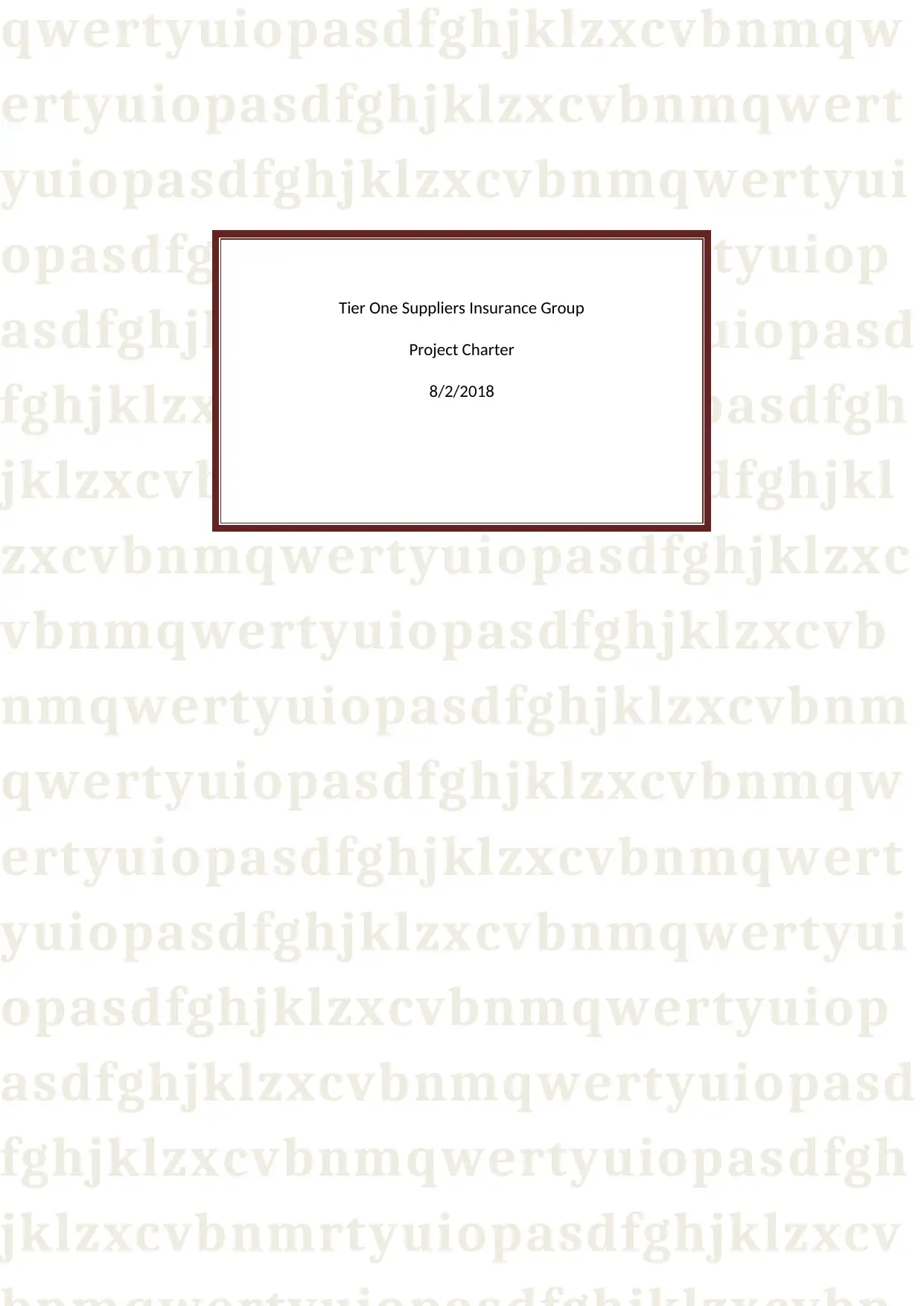
qwertyuiopasdfghjklzxcvbnmqw
ertyuiopasdfghjklzxcvbnmqwert
yuiopasdfghjklzxcvbnmqwertyui
opasdfghjklzxcvbnmqwertyuiop
asdfghjklzxcvbnmqwertyuiopasd
fghjklzxcvbnmqwertyuiopasdfgh
jklzxcvbnmqwertyuiopasdfghjkl
zxcvbnmqwertyuiopasdfghjklzxc
vbnmqwertyuiopasdfghjklzxcvb
nmqwertyuiopasdfghjklzxcvbnm
qwertyuiopasdfghjklzxcvbnmqw
ertyuiopasdfghjklzxcvbnmqwert
yuiopasdfghjklzxcvbnmqwertyui
opasdfghjklzxcvbnmqwertyuiop
asdfghjklzxcvbnmqwertyuiopasd
fghjklzxcvbnmqwertyuiopasdfgh
jklzxcvbnmrtyuiopasdfghjklzxcv
Tier One Suppliers Insurance Group
Project Charter
8/2/2018
ertyuiopasdfghjklzxcvbnmqwert
yuiopasdfghjklzxcvbnmqwertyui
opasdfghjklzxcvbnmqwertyuiop
asdfghjklzxcvbnmqwertyuiopasd
fghjklzxcvbnmqwertyuiopasdfgh
jklzxcvbnmqwertyuiopasdfghjkl
zxcvbnmqwertyuiopasdfghjklzxc
vbnmqwertyuiopasdfghjklzxcvb
nmqwertyuiopasdfghjklzxcvbnm
qwertyuiopasdfghjklzxcvbnmqw
ertyuiopasdfghjklzxcvbnmqwert
yuiopasdfghjklzxcvbnmqwertyui
opasdfghjklzxcvbnmqwertyuiop
asdfghjklzxcvbnmqwertyuiopasd
fghjklzxcvbnmqwertyuiopasdfgh
jklzxcvbnmrtyuiopasdfghjklzxcv
Tier One Suppliers Insurance Group
Project Charter
8/2/2018
Paraphrase This Document
Need a fresh take? Get an instant paraphrase of this document with our AI Paraphraser
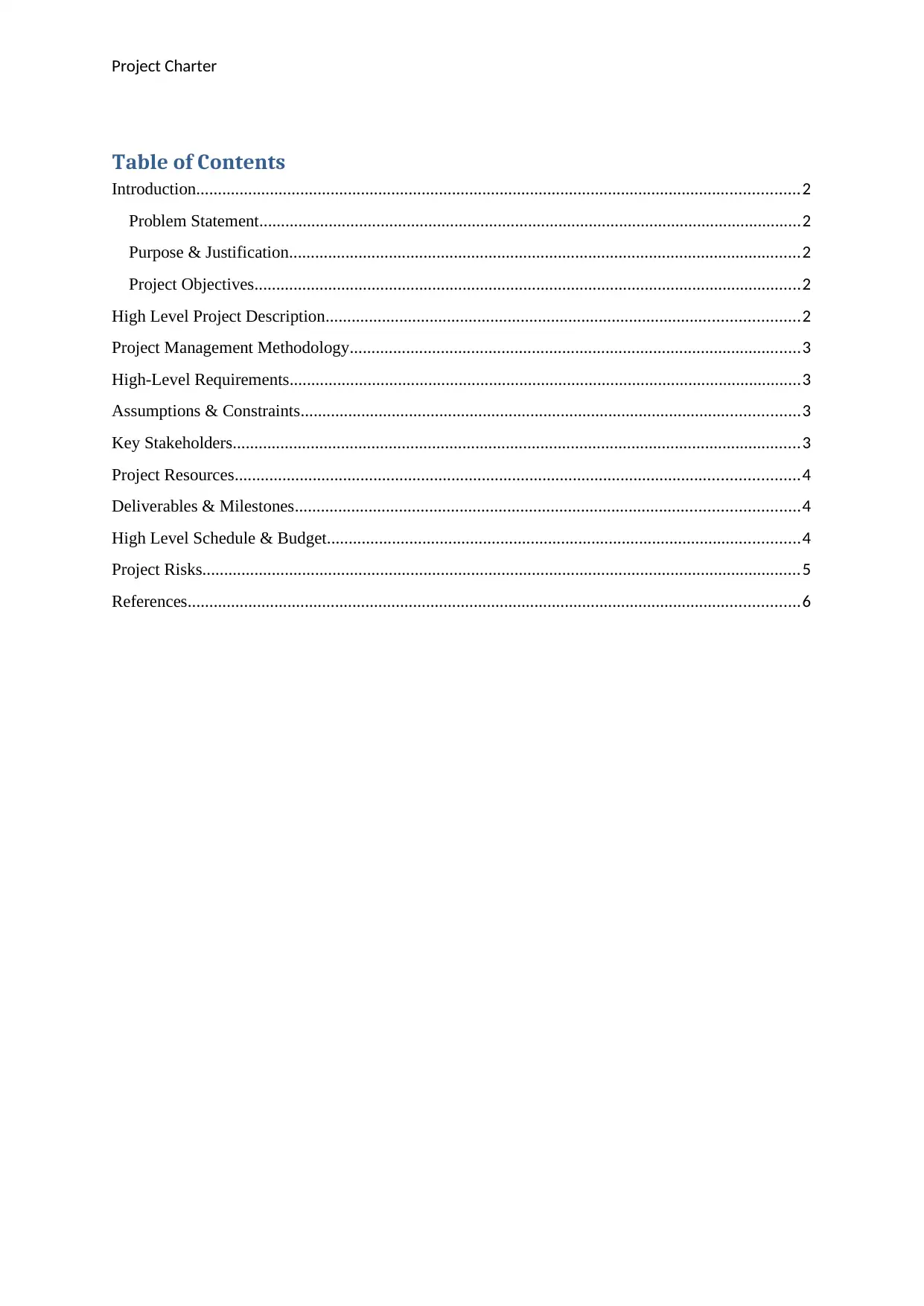
Project Charter
Table of Contents
Introduction...........................................................................................................................................2
Problem Statement.............................................................................................................................2
Purpose & Justification......................................................................................................................2
Project Objectives..............................................................................................................................2
High Level Project Description.............................................................................................................2
Project Management Methodology........................................................................................................3
High-Level Requirements......................................................................................................................3
Assumptions & Constraints...................................................................................................................3
Key Stakeholders...................................................................................................................................3
Project Resources..................................................................................................................................4
Deliverables & Milestones....................................................................................................................4
High Level Schedule & Budget.............................................................................................................4
Project Risks..........................................................................................................................................5
References.............................................................................................................................................6
Table of Contents
Introduction...........................................................................................................................................2
Problem Statement.............................................................................................................................2
Purpose & Justification......................................................................................................................2
Project Objectives..............................................................................................................................2
High Level Project Description.............................................................................................................2
Project Management Methodology........................................................................................................3
High-Level Requirements......................................................................................................................3
Assumptions & Constraints...................................................................................................................3
Key Stakeholders...................................................................................................................................3
Project Resources..................................................................................................................................4
Deliverables & Milestones....................................................................................................................4
High Level Schedule & Budget.............................................................................................................4
Project Risks..........................................................................................................................................5
References.............................................................................................................................................6
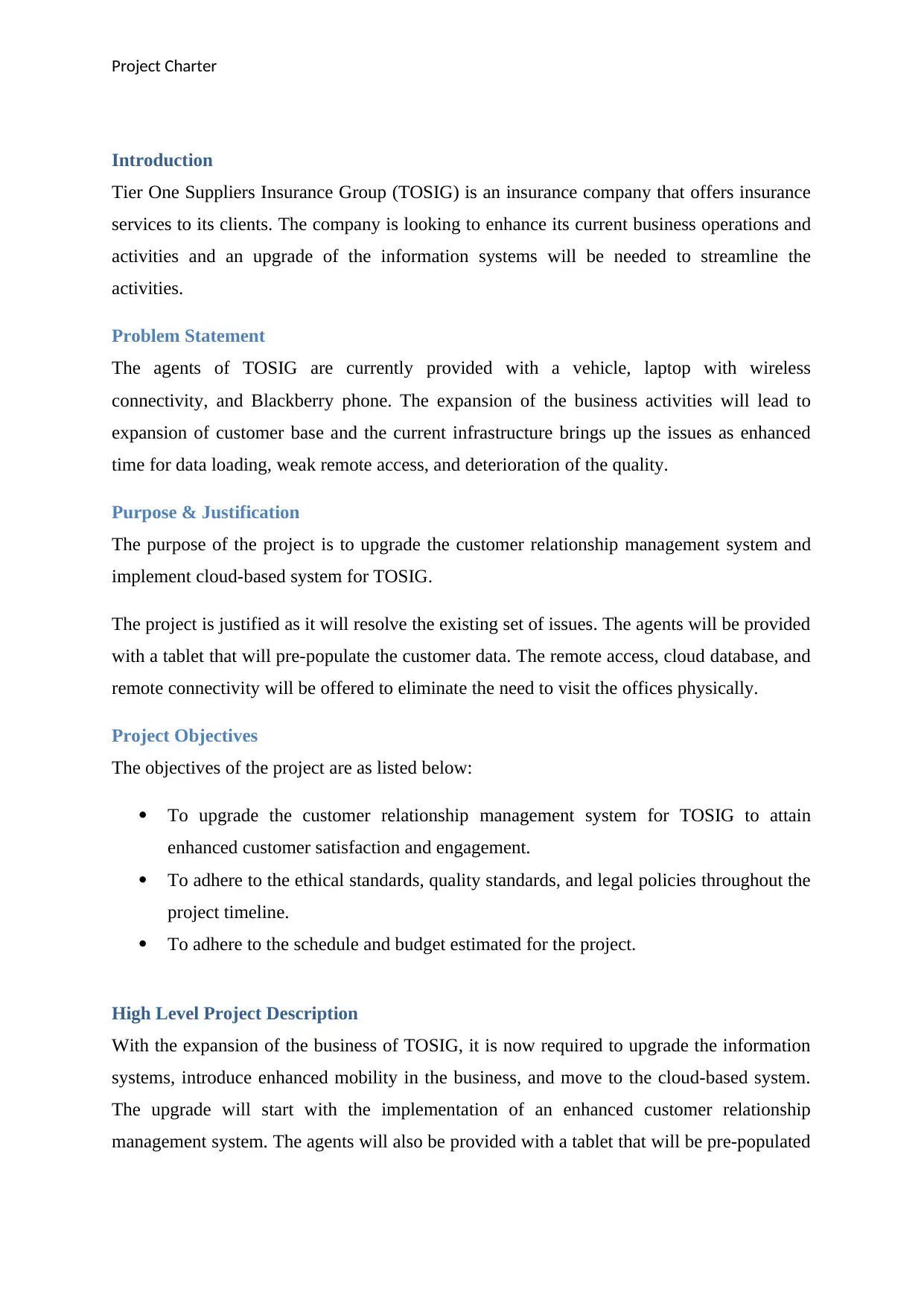
Project Charter
Introduction
Tier One Suppliers Insurance Group (TOSIG) is an insurance company that offers insurance
services to its clients. The company is looking to enhance its current business operations and
activities and an upgrade of the information systems will be needed to streamline the
activities.
Problem Statement
The agents of TOSIG are currently provided with a vehicle, laptop with wireless
connectivity, and Blackberry phone. The expansion of the business activities will lead to
expansion of customer base and the current infrastructure brings up the issues as enhanced
time for data loading, weak remote access, and deterioration of the quality.
Purpose & Justification
The purpose of the project is to upgrade the customer relationship management system and
implement cloud-based system for TOSIG.
The project is justified as it will resolve the existing set of issues. The agents will be provided
with a tablet that will pre-populate the customer data. The remote access, cloud database, and
remote connectivity will be offered to eliminate the need to visit the offices physically.
Project Objectives
The objectives of the project are as listed below:
To upgrade the customer relationship management system for TOSIG to attain
enhanced customer satisfaction and engagement.
To adhere to the ethical standards, quality standards, and legal policies throughout the
project timeline.
To adhere to the schedule and budget estimated for the project.
High Level Project Description
With the expansion of the business of TOSIG, it is now required to upgrade the information
systems, introduce enhanced mobility in the business, and move to the cloud-based system.
The upgrade will start with the implementation of an enhanced customer relationship
management system. The agents will also be provided with a tablet that will be pre-populated
Introduction
Tier One Suppliers Insurance Group (TOSIG) is an insurance company that offers insurance
services to its clients. The company is looking to enhance its current business operations and
activities and an upgrade of the information systems will be needed to streamline the
activities.
Problem Statement
The agents of TOSIG are currently provided with a vehicle, laptop with wireless
connectivity, and Blackberry phone. The expansion of the business activities will lead to
expansion of customer base and the current infrastructure brings up the issues as enhanced
time for data loading, weak remote access, and deterioration of the quality.
Purpose & Justification
The purpose of the project is to upgrade the customer relationship management system and
implement cloud-based system for TOSIG.
The project is justified as it will resolve the existing set of issues. The agents will be provided
with a tablet that will pre-populate the customer data. The remote access, cloud database, and
remote connectivity will be offered to eliminate the need to visit the offices physically.
Project Objectives
The objectives of the project are as listed below:
To upgrade the customer relationship management system for TOSIG to attain
enhanced customer satisfaction and engagement.
To adhere to the ethical standards, quality standards, and legal policies throughout the
project timeline.
To adhere to the schedule and budget estimated for the project.
High Level Project Description
With the expansion of the business of TOSIG, it is now required to upgrade the information
systems, introduce enhanced mobility in the business, and move to the cloud-based system.
The upgrade will start with the implementation of an enhanced customer relationship
management system. The agents will also be provided with a tablet that will be pre-populated
⊘ This is a preview!⊘
Do you want full access?
Subscribe today to unlock all pages.

Trusted by 1+ million students worldwide
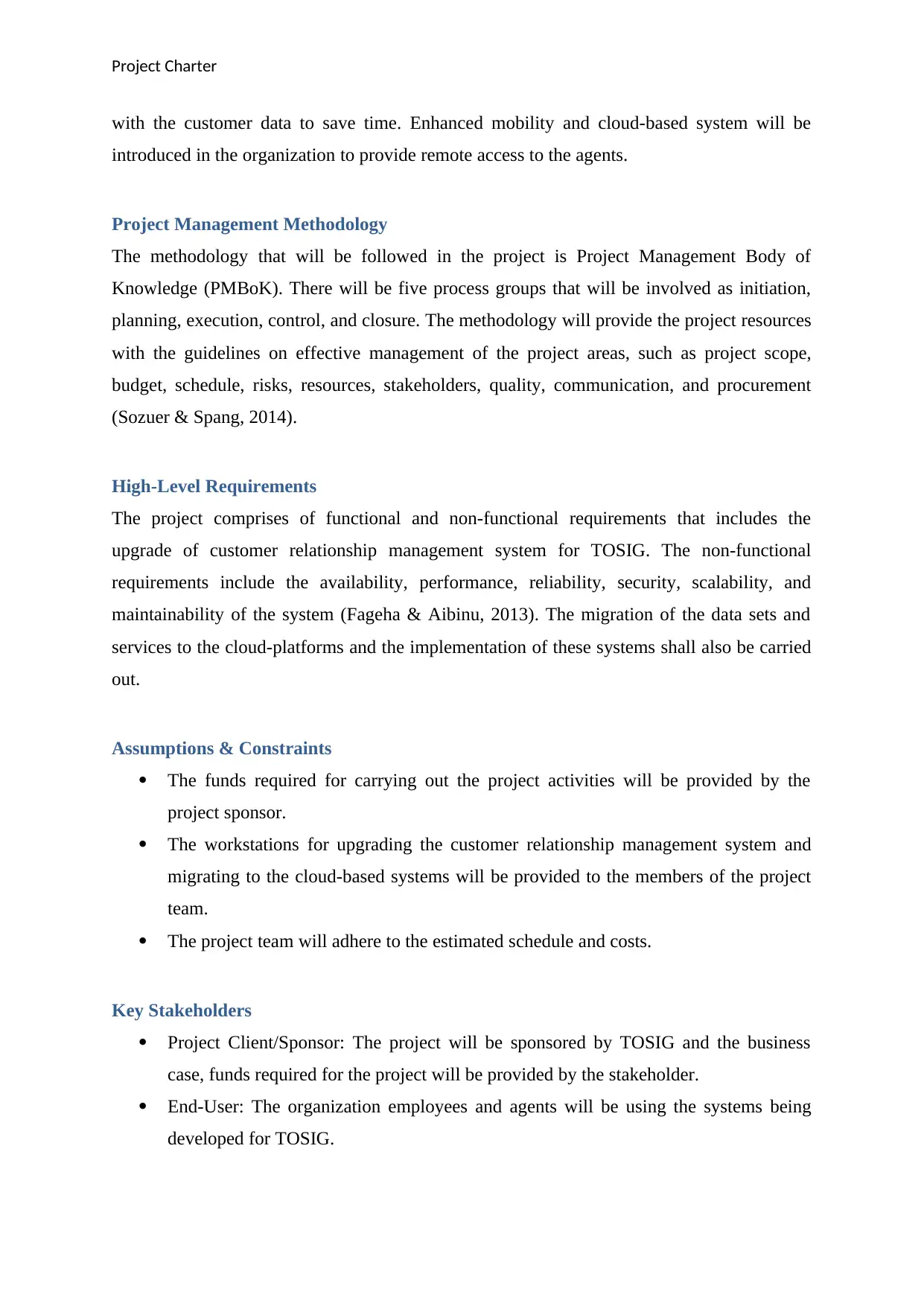
Project Charter
with the customer data to save time. Enhanced mobility and cloud-based system will be
introduced in the organization to provide remote access to the agents.
Project Management Methodology
The methodology that will be followed in the project is Project Management Body of
Knowledge (PMBoK). There will be five process groups that will be involved as initiation,
planning, execution, control, and closure. The methodology will provide the project resources
with the guidelines on effective management of the project areas, such as project scope,
budget, schedule, risks, resources, stakeholders, quality, communication, and procurement
(Sozuer & Spang, 2014).
High-Level Requirements
The project comprises of functional and non-functional requirements that includes the
upgrade of customer relationship management system for TOSIG. The non-functional
requirements include the availability, performance, reliability, security, scalability, and
maintainability of the system (Fageha & Aibinu, 2013). The migration of the data sets and
services to the cloud-platforms and the implementation of these systems shall also be carried
out.
Assumptions & Constraints
The funds required for carrying out the project activities will be provided by the
project sponsor.
The workstations for upgrading the customer relationship management system and
migrating to the cloud-based systems will be provided to the members of the project
team.
The project team will adhere to the estimated schedule and costs.
Key Stakeholders
Project Client/Sponsor: The project will be sponsored by TOSIG and the business
case, funds required for the project will be provided by the stakeholder.
End-User: The organization employees and agents will be using the systems being
developed for TOSIG.
with the customer data to save time. Enhanced mobility and cloud-based system will be
introduced in the organization to provide remote access to the agents.
Project Management Methodology
The methodology that will be followed in the project is Project Management Body of
Knowledge (PMBoK). There will be five process groups that will be involved as initiation,
planning, execution, control, and closure. The methodology will provide the project resources
with the guidelines on effective management of the project areas, such as project scope,
budget, schedule, risks, resources, stakeholders, quality, communication, and procurement
(Sozuer & Spang, 2014).
High-Level Requirements
The project comprises of functional and non-functional requirements that includes the
upgrade of customer relationship management system for TOSIG. The non-functional
requirements include the availability, performance, reliability, security, scalability, and
maintainability of the system (Fageha & Aibinu, 2013). The migration of the data sets and
services to the cloud-platforms and the implementation of these systems shall also be carried
out.
Assumptions & Constraints
The funds required for carrying out the project activities will be provided by the
project sponsor.
The workstations for upgrading the customer relationship management system and
migrating to the cloud-based systems will be provided to the members of the project
team.
The project team will adhere to the estimated schedule and costs.
Key Stakeholders
Project Client/Sponsor: The project will be sponsored by TOSIG and the business
case, funds required for the project will be provided by the stakeholder.
End-User: The organization employees and agents will be using the systems being
developed for TOSIG.
Paraphrase This Document
Need a fresh take? Get an instant paraphrase of this document with our AI Paraphraser
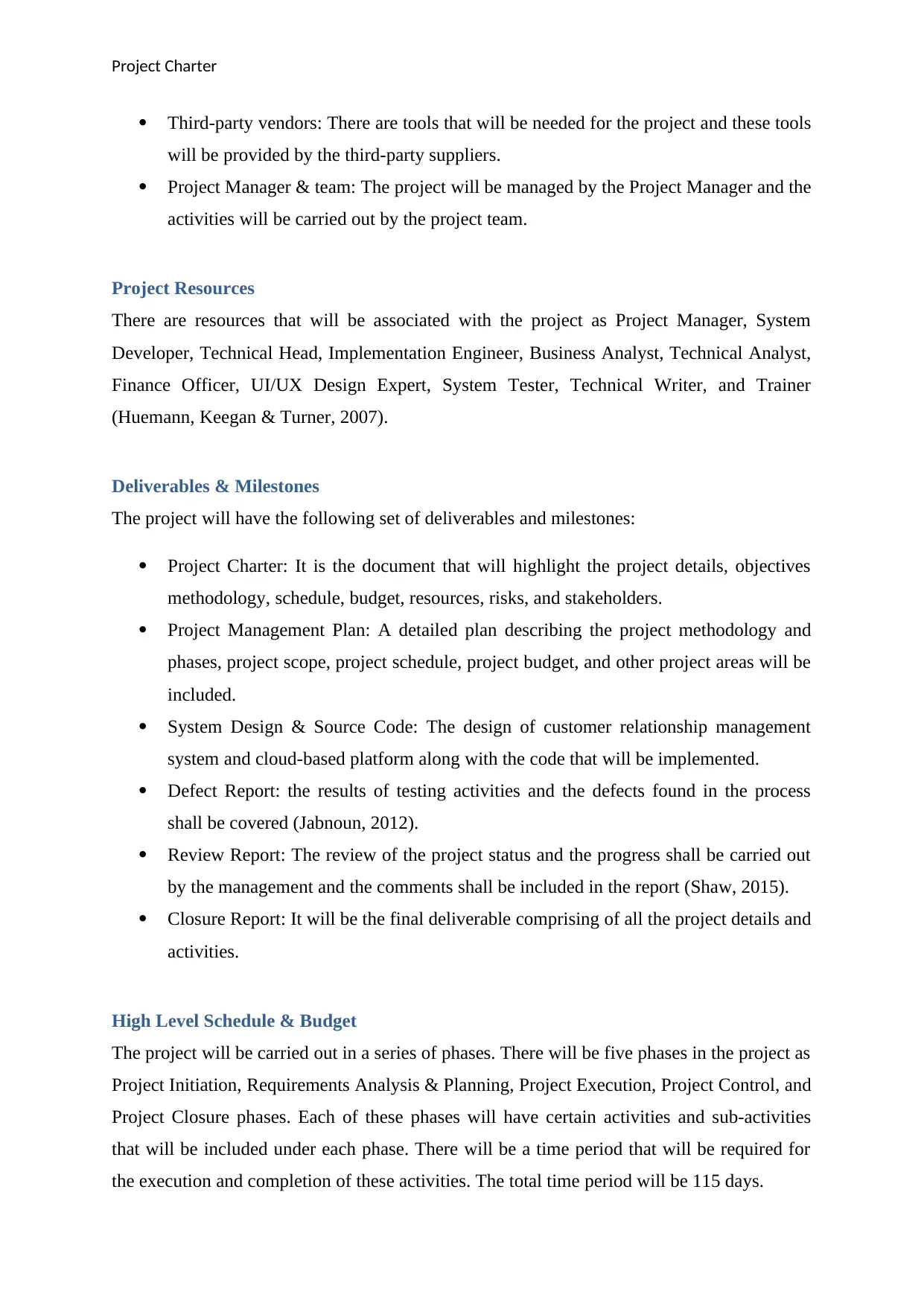
Project Charter
Third-party vendors: There are tools that will be needed for the project and these tools
will be provided by the third-party suppliers.
Project Manager & team: The project will be managed by the Project Manager and the
activities will be carried out by the project team.
Project Resources
There are resources that will be associated with the project as Project Manager, System
Developer, Technical Head, Implementation Engineer, Business Analyst, Technical Analyst,
Finance Officer, UI/UX Design Expert, System Tester, Technical Writer, and Trainer
(Huemann, Keegan & Turner, 2007).
Deliverables & Milestones
The project will have the following set of deliverables and milestones:
Project Charter: It is the document that will highlight the project details, objectives
methodology, schedule, budget, resources, risks, and stakeholders.
Project Management Plan: A detailed plan describing the project methodology and
phases, project scope, project schedule, project budget, and other project areas will be
included.
System Design & Source Code: The design of customer relationship management
system and cloud-based platform along with the code that will be implemented.
Defect Report: the results of testing activities and the defects found in the process
shall be covered (Jabnoun, 2012).
Review Report: The review of the project status and the progress shall be carried out
by the management and the comments shall be included in the report (Shaw, 2015).
Closure Report: It will be the final deliverable comprising of all the project details and
activities.
High Level Schedule & Budget
The project will be carried out in a series of phases. There will be five phases in the project as
Project Initiation, Requirements Analysis & Planning, Project Execution, Project Control, and
Project Closure phases. Each of these phases will have certain activities and sub-activities
that will be included under each phase. There will be a time period that will be required for
the execution and completion of these activities. The total time period will be 115 days.
Third-party vendors: There are tools that will be needed for the project and these tools
will be provided by the third-party suppliers.
Project Manager & team: The project will be managed by the Project Manager and the
activities will be carried out by the project team.
Project Resources
There are resources that will be associated with the project as Project Manager, System
Developer, Technical Head, Implementation Engineer, Business Analyst, Technical Analyst,
Finance Officer, UI/UX Design Expert, System Tester, Technical Writer, and Trainer
(Huemann, Keegan & Turner, 2007).
Deliverables & Milestones
The project will have the following set of deliverables and milestones:
Project Charter: It is the document that will highlight the project details, objectives
methodology, schedule, budget, resources, risks, and stakeholders.
Project Management Plan: A detailed plan describing the project methodology and
phases, project scope, project schedule, project budget, and other project areas will be
included.
System Design & Source Code: The design of customer relationship management
system and cloud-based platform along with the code that will be implemented.
Defect Report: the results of testing activities and the defects found in the process
shall be covered (Jabnoun, 2012).
Review Report: The review of the project status and the progress shall be carried out
by the management and the comments shall be included in the report (Shaw, 2015).
Closure Report: It will be the final deliverable comprising of all the project details and
activities.
High Level Schedule & Budget
The project will be carried out in a series of phases. There will be five phases in the project as
Project Initiation, Requirements Analysis & Planning, Project Execution, Project Control, and
Project Closure phases. Each of these phases will have certain activities and sub-activities
that will be included under each phase. There will be a time period that will be required for
the execution and completion of these activities. The total time period will be 115 days.
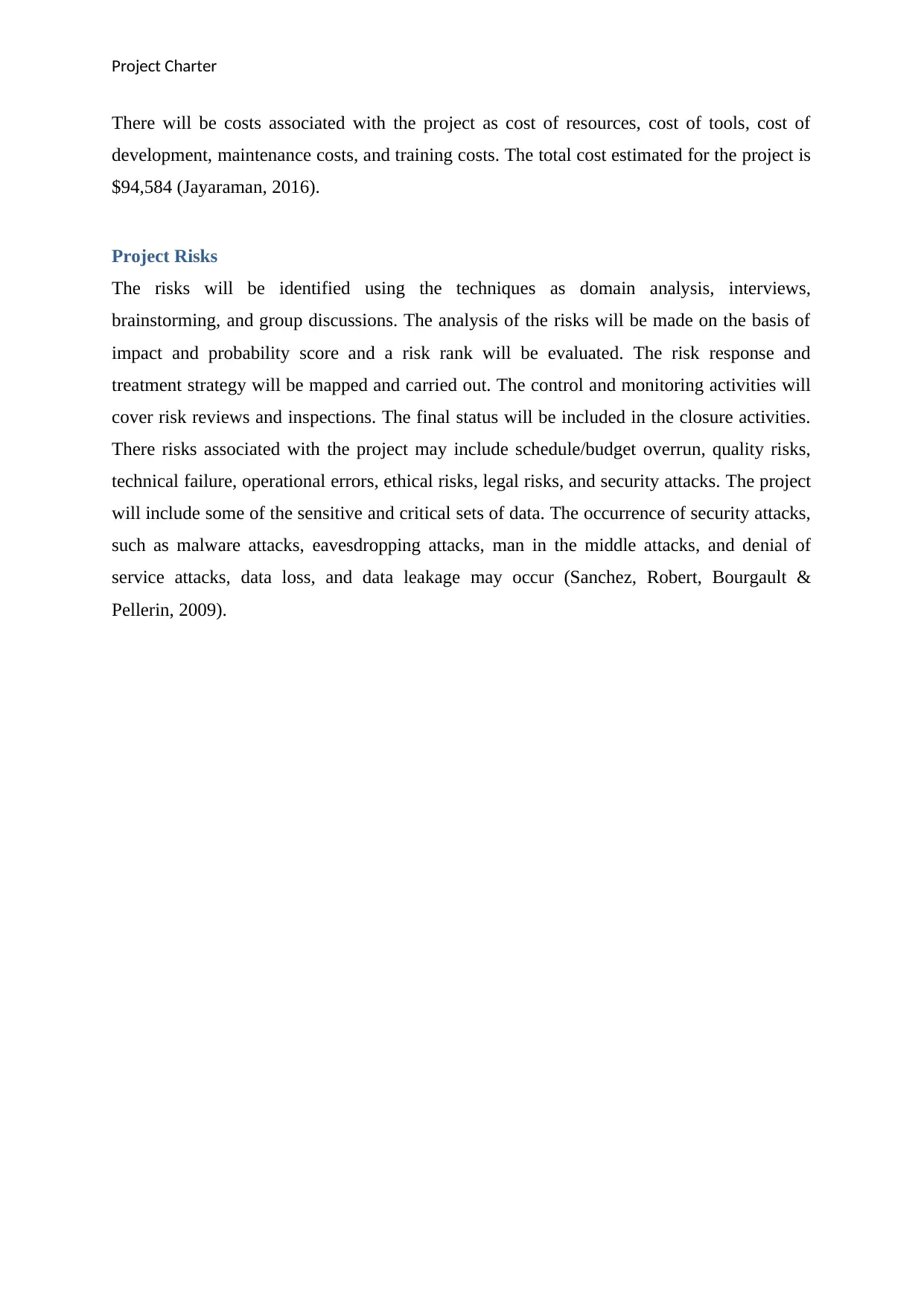
Project Charter
There will be costs associated with the project as cost of resources, cost of tools, cost of
development, maintenance costs, and training costs. The total cost estimated for the project is
$94,584 (Jayaraman, 2016).
Project Risks
The risks will be identified using the techniques as domain analysis, interviews,
brainstorming, and group discussions. The analysis of the risks will be made on the basis of
impact and probability score and a risk rank will be evaluated. The risk response and
treatment strategy will be mapped and carried out. The control and monitoring activities will
cover risk reviews and inspections. The final status will be included in the closure activities.
There risks associated with the project may include schedule/budget overrun, quality risks,
technical failure, operational errors, ethical risks, legal risks, and security attacks. The project
will include some of the sensitive and critical sets of data. The occurrence of security attacks,
such as malware attacks, eavesdropping attacks, man in the middle attacks, and denial of
service attacks, data loss, and data leakage may occur (Sanchez, Robert, Bourgault &
Pellerin, 2009).
There will be costs associated with the project as cost of resources, cost of tools, cost of
development, maintenance costs, and training costs. The total cost estimated for the project is
$94,584 (Jayaraman, 2016).
Project Risks
The risks will be identified using the techniques as domain analysis, interviews,
brainstorming, and group discussions. The analysis of the risks will be made on the basis of
impact and probability score and a risk rank will be evaluated. The risk response and
treatment strategy will be mapped and carried out. The control and monitoring activities will
cover risk reviews and inspections. The final status will be included in the closure activities.
There risks associated with the project may include schedule/budget overrun, quality risks,
technical failure, operational errors, ethical risks, legal risks, and security attacks. The project
will include some of the sensitive and critical sets of data. The occurrence of security attacks,
such as malware attacks, eavesdropping attacks, man in the middle attacks, and denial of
service attacks, data loss, and data leakage may occur (Sanchez, Robert, Bourgault &
Pellerin, 2009).
⊘ This is a preview!⊘
Do you want full access?
Subscribe today to unlock all pages.

Trusted by 1+ million students worldwide
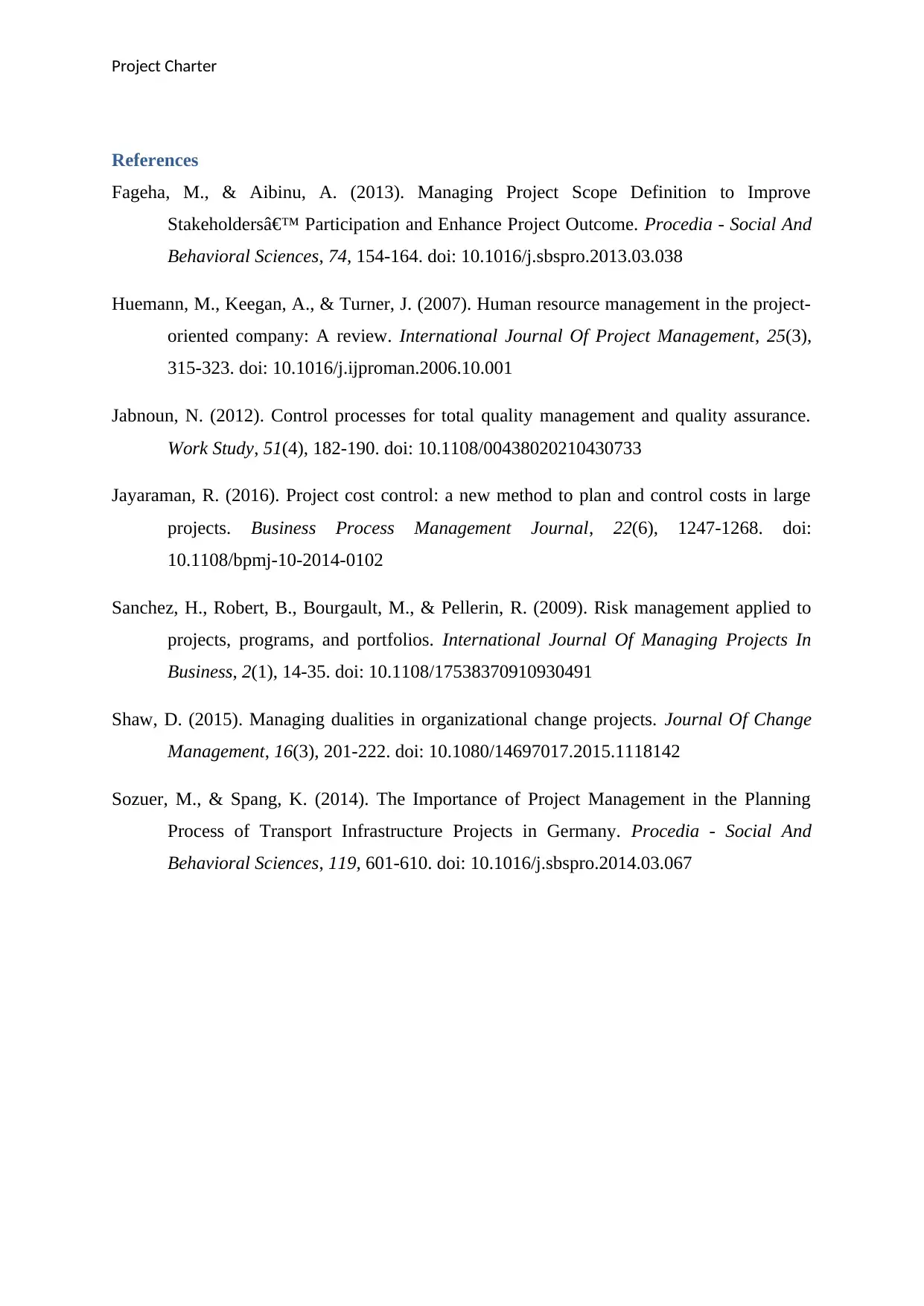
Project Charter
References
Fageha, M., & Aibinu, A. (2013). Managing Project Scope Definition to Improve
Stakeholders’ Participation and Enhance Project Outcome. Procedia - Social And
Behavioral Sciences, 74, 154-164. doi: 10.1016/j.sbspro.2013.03.038
Huemann, M., Keegan, A., & Turner, J. (2007). Human resource management in the project-
oriented company: A review. International Journal Of Project Management, 25(3),
315-323. doi: 10.1016/j.ijproman.2006.10.001
Jabnoun, N. (2012). Control processes for total quality management and quality assurance.
Work Study, 51(4), 182-190. doi: 10.1108/00438020210430733
Jayaraman, R. (2016). Project cost control: a new method to plan and control costs in large
projects. Business Process Management Journal, 22(6), 1247-1268. doi:
10.1108/bpmj-10-2014-0102
Sanchez, H., Robert, B., Bourgault, M., & Pellerin, R. (2009). Risk management applied to
projects, programs, and portfolios. International Journal Of Managing Projects In
Business, 2(1), 14-35. doi: 10.1108/17538370910930491
Shaw, D. (2015). Managing dualities in organizational change projects. Journal Of Change
Management, 16(3), 201-222. doi: 10.1080/14697017.2015.1118142
Sozuer, M., & Spang, K. (2014). The Importance of Project Management in the Planning
Process of Transport Infrastructure Projects in Germany. Procedia - Social And
Behavioral Sciences, 119, 601-610. doi: 10.1016/j.sbspro.2014.03.067
References
Fageha, M., & Aibinu, A. (2013). Managing Project Scope Definition to Improve
Stakeholders’ Participation and Enhance Project Outcome. Procedia - Social And
Behavioral Sciences, 74, 154-164. doi: 10.1016/j.sbspro.2013.03.038
Huemann, M., Keegan, A., & Turner, J. (2007). Human resource management in the project-
oriented company: A review. International Journal Of Project Management, 25(3),
315-323. doi: 10.1016/j.ijproman.2006.10.001
Jabnoun, N. (2012). Control processes for total quality management and quality assurance.
Work Study, 51(4), 182-190. doi: 10.1108/00438020210430733
Jayaraman, R. (2016). Project cost control: a new method to plan and control costs in large
projects. Business Process Management Journal, 22(6), 1247-1268. doi:
10.1108/bpmj-10-2014-0102
Sanchez, H., Robert, B., Bourgault, M., & Pellerin, R. (2009). Risk management applied to
projects, programs, and portfolios. International Journal Of Managing Projects In
Business, 2(1), 14-35. doi: 10.1108/17538370910930491
Shaw, D. (2015). Managing dualities in organizational change projects. Journal Of Change
Management, 16(3), 201-222. doi: 10.1080/14697017.2015.1118142
Sozuer, M., & Spang, K. (2014). The Importance of Project Management in the Planning
Process of Transport Infrastructure Projects in Germany. Procedia - Social And
Behavioral Sciences, 119, 601-610. doi: 10.1016/j.sbspro.2014.03.067
1 out of 7
Related Documents
Your All-in-One AI-Powered Toolkit for Academic Success.
+13062052269
info@desklib.com
Available 24*7 on WhatsApp / Email
![[object Object]](/_next/static/media/star-bottom.7253800d.svg)
Unlock your academic potential
Copyright © 2020–2025 A2Z Services. All Rights Reserved. Developed and managed by ZUCOL.





